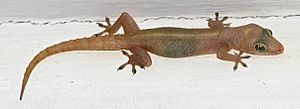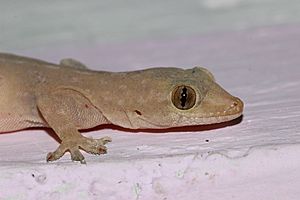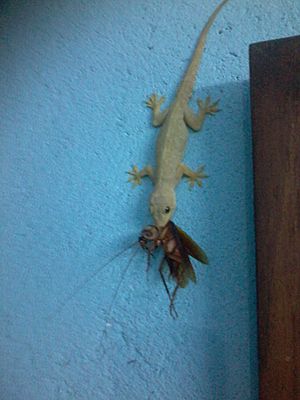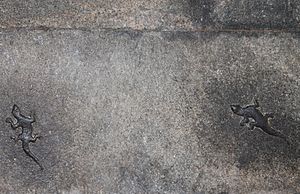Common house gecko facts for kids
Quick facts for kids Common house gecko |
|
|---|---|
 |
|
| Conservation status | |
| Scientific classification | |
| Genus: |
Hemidactylus
|
| Species: |
frenatus
|
 |
|
The common house gecko (Hemidactylus frenatus) is a small gecko that originally comes from Southeast Asia. You might also hear it called the Asian house gecko, Pacific house gecko, wall gecko, house lizard, or moon lizard.
Most geckos are active at night, which means they are nocturnal. They hide during the day and come out at night to hunt for insects. You can often spot them climbing on the walls of houses and other buildings. They look for insects that are drawn to outdoor lights. You can easily recognize them by their special chirping sound.
These geckos usually grow to be about 7.5 to 15 centimeters (3 to 6 inches) long. They live for around 5 years. Common house geckos are not venomous and are not harmful to people. Most geckos are calm, but they might bite if they feel scared. Their bite can sometimes break the skin.
The common house gecko loves warm, humid places. It can be found crawling on old wood looking for insects to eat. It also lives well in cities and towns. This animal is very good at adapting to new places. It can eat many kinds of insects and spiders. Sometimes, it even pushes out other gecko species that are not as strong or aggressive.
Contents
- Where Common House Geckos Live and What They Eat
- Where Common House Geckos are Found
- Common House Geckos as an Invasive Species
- How Common House Geckos Work (Physiology)
- Common House Gecko Reproduction and Life Cycle
- Genetics of Common House Geckos
- What's in a Name? (Etymology)
- Keeping House Geckos as Pets
- Cultural Beliefs About Geckos
- Images for kids
- See also
Where Common House Geckos Live and What They Eat
The common house gecko really lives up to its name because it clearly prefers to live in cities and towns. These geckos like to hunt for insects close to city lights. While they have been found in wild areas, it seems they mostly prefer places near or inside cities.
Common house geckos like areas with light, especially if there are cracks or places nearby where they can quickly hide. If a gecko doesn't have an easy escape route, it will change its behavior. It might come out later at night and go back into hiding earlier in the morning. When they are not in cities, they seem to prefer thick forests or eucalyptus woodlands near closed forests.
Living in cities helps the common house gecko find its favorite foods. Most of their diet is made up of invertebrates, which are animals without backbones. They mostly hunt these around buildings. Their main food sources include cockroaches, termites, some bees and wasps, butterflies, moths, flies, spiders, and different types of beetles. Scientists have seen them eat other geckos in labs, but this has not been seen much in the wild.
Where Common House Geckos are Found
The common house gecko is found all over tropical and subtropical parts of the world. It can live in similar places as other Hemidactylus gecko species. Even though it is native to Southeast Asia, it has spread to many new places. This has happened both by accident and on purpose.
Now, you can find them in the southern United States, large parts of tropical Australia, and many other countries in South and Central America, Africa, South Asia, and the Middle East. They can survive in many different climates because they can go into a special sleep called brumation during colder months. As the climate changes and more cities are built, the common house gecko might spread even further. Because people worry it could become an invasive species, there are efforts to stop it from spreading to places where it might harm native gecko species.
In Mexico, the common house gecko was first found in Acapulco in 1895. By the early 1940s, it was well-established there. It probably arrived on ships and cargo. Now, it lives in many low-lying areas of Mexico, including the Yucatan Peninsula and Baja California. Most of the time, these geckos are found in buildings like homes and hotels in cities. There are only a few reports of them living in natural habitats. We don't know yet if they are harming native animals in Mexico.
Common House Geckos as an Invasive Species
There is evidence that common house geckos have caused problems for native gecko populations in tropical Asia, Central America, and the Pacific.
Some gecko species that have been affected include:
- Lepidodactylus lugubris
- Hemidactylus garnotti
- Three species from the Nactus genus on the Mascarene Islands, which are now extinct.
When common house geckos are introduced to a new area, they can bring new parasites and diseases. But their main threat comes from how they push out and outcompete other gecko species. Scientists have found three main reasons why H. frenatus is so good at outcompeting other geckos:
- They are smaller than some native species. They usually don't push out native species that are larger than them, like the robust velvet gecko.
- Male common house geckos are more aggressive than females of other gecko species, especially those that reproduce without a male.
- Female common house geckos that reproduce sexually are better at competing than females that reproduce asexually.
These differences give H. frenatus an advantage in the limited city areas they prefer. This is especially true in places where habitats are broken up into small pieces. Also, they can live in higher numbers in an area. This means you might see more geckos overall, even if the number of native species goes down. Common house geckos can also handle brighter lights, which might help them hunt better. There is also some evidence that they might eat other small gecko species, especially young ones. However, most of this evidence comes from lab studies, and it has not been seen much in the wild.
Some male geckos are more territorial than others. These males have larger heads with a more noticeable shape. But having a bigger head means they are slower when trying to escape. This suggests that being able to bite strongly is more important for males than being able to run away quickly. On the other hand, when female heads get bigger, their back legs also get longer, and their speed does not decrease. Both male and female geckos run to escape danger. However, males are more likely to stop and fight by biting because their bigger heads make them less mobile. This is linked to how they defend their territory.
The success of the common house gecko can also be explained by how they interact with other geckos. For example, the common house gecko can make the mourning gecko avoid an area where food might be available. Even though they make other species avoid them, common house geckos can tolerate other gecko species well. This is true whether the other species are smaller or larger, faster or slower, or more aggressive. This allows them to get more access to food areas and territories, making them a very successful invasive species.
How Common House Geckos Work (Physiology)
The common house gecko is ectothermic, which means it is "cold-blooded." It uses different behaviors to control its body temperature. How its body works affects where it lives, how it interacts with native species, and how well it reproduces in new places.
The common house gecko uses oxygen at a similar rate to other lizards of its size. It can control its body temperature when the environment is between 26 and 35 degrees Celsius (79-95°F). This means it can change its body temperature through its actions. For example, it might choose to sit in sunlight or on certain surfaces. Its breathing rate depends on the temperature when it's very hot, but not when it's colder.
Common house geckos are mostly active during the day to warm up and then hunt at night. They often warm up in bright places near cracks where they can hide. Their activity levels are closely linked to the air temperature. Light levels also affect their daily rhythm. They tend to be most numerous around midnight, with the most activity right after sunset. This activity slowly decreases until dawn. Differences in daily cycles from place to place are usually due to things like human activity and building structures. Hunting most actively after dark helps them find insects that gather around artificial lights in cities.
Because they depend so much on their environment, drops in temperature can lead to fewer gecko sightings. Bad weather like rain or wind will also cause fewer geckos to be seen. We are not sure how these events affect the long-term spread of the common house gecko or its ability to compete with other gecko species.
There is some weak evidence that female geckos prefer slightly higher temperatures. This could help their eggs develop faster. However, there isn't enough strong data to prove this.
Since they are adapted for tropical or subtropical environments, they don't seem to have many special body features to prevent water loss. This might limit their ability to live in very dry areas.
Common House Gecko Reproduction and Life Cycle
H. frenatus has a similar body structure for reproduction as other geckos. You can tell the sex of larger common house geckos. Those bigger than 40mm (about 1.5 inches) usually have clear differences in their reproductive organs. In males, you can see a swelling near the cloaca (a body opening) caused by their reproductive organs. Females lay a maximum of two hard-shelled eggs at a time. Each egg comes from a single oviduct. A female can have up to four eggs in her ovaries at different stages of development. This means she can lay eggs more often. Females produce one egg per ovary per cycle.
Male geckos have mature sperm all year round. Females can store sperm inside their oviduct for as long as 36 weeks. This greatly increases their chances of starting new populations in new places, as fewer geckos are needed to succeed. However, storing sperm for a long time can lead to lower survival rates for the eggs and young. Sperm is stored in a specific part of the oviduct. Being able to store sperm means that mating, ovulation, and egg-laying don't have to happen at the same time. This is very helpful for geckos colonizing islands. A female who is alone can still reproduce even if she has been separated from a male for a while. In labs, one mating event can lead to as many as seven groups of eggs. This means they don't need to reproduce without a male (asexually). The young can include both male and female offspring. This also makes the young stronger and more diverse. Geckos that reproduce sexually are also reported to be stronger and survive better than those that reproduce asexually.
Larger geckos tend to lay eggs that are more likely to survive. Also, warmer temperatures all year round and a steady food supply are linked to when geckos reproduce. Geckos with constant food and temperatures are less likely to develop fat on their stomachs and are more likely to reproduce all the time.
Genetics of Common House Geckos
There seem to be two different types of common house geckos based on their karyotype (the number and appearance of chromosomes). One type has 40 chromosomes, and the other has 46. This could mean that there are differences within the same species, or it could mean that two different species have been mistaken for one. Scientists might need to re-examine how these geckos are classified as they learn more about their family trees and populations.
What's in a Name? (Etymology)
Like many geckos, this species can lose its tail if it feels scared. Its call or chirp sounds a bit like "gecko, gecko." But people describe the sound in different ways, like "tchak tchak tchak," often repeated six to nine times.
In Asia and Southeast Asia, especially Indonesia, Thailand, Singapore, and Malaysia, geckos have local names that sound like the noises they make. The common house gecko is called "chee chak" or "chi chak" (pronounced chee chuck) in Malay. In the Philippines, they are called "butiki" in Tagalog and "tiki" in Visayan. In Thailand, they are called "jing-jok" (Thai: จิ้งจก). In Myanmar, they are called "အိမ်မြှောင် - ain-mjong," which means "house stick to." In parts of India and Pakistan, they are called "chhipkali" (Urdu: چھپکلی, Hindi: छिपकली), which comes from a word meaning "to stick." In Nepal, they are called "vhitti" (Nepali: भित्ती) or "mausuli" (Nepali: माउसुली). In other parts of India, they have many names like "kirli" (Punjabi: ਕਿੜਲੀ), "jhiti piti" (Oriya: ଝିଟିପିଟି), "zethi" (Assamese: জেঠী), "thikthikiaa" (Maithili: ठिकठिकिया), "paal" (Marathi: पाल), "gawli" or "palli" (Malayalam: ഗവ്ളി (gawli), പല്ലി (palli), Tamil: பல்லி (palli)), Telugu: బల్లి (balli), Kannada: ಹಲ್ಲಿ (halli), "ali" (Sylheti: ꠀꠟꠤ), and "garoli" (Gujarati: ગરોળી). In West Bengal and Bangladesh, they are called "tiktiki" (Bengali: টিকটিকি) because their sound is heard as "tik tik tik." In Sri Lanka, they are called "huna" (Sinhalese: හුනා). In Central America, they are sometimes called "limpia casas" (Spanish: "house cleaners") because they help reduce insects in homes. They are also called 'qui-qui' because of the sound they make.
Keeping House Geckos as Pets
You can keep house geckos as pets in a special enclosure called a vivarium. This enclosure needs a clean bottom, a heat source, and a place for the gecko to hide to control its body temperature. It also needs humidifiers and plants to give the gecko moisture.
These geckos can stick to vertical surfaces or even hang upside down when they are resting. In a terrarium, they will usually rest on the sides or on the top cover, rather than on plants or decorations. This makes them quite easy to see.
House geckos are also sometimes used as food for certain types of snakes.
Cultural Beliefs About Geckos
In many parts of the world, people used to believe that geckos were venomous. However, in Southeast Asia, geckos are often thought to bring good luck. In the Philippines, if a gecko makes a ticking sound, people believe it means a visitor or a letter will arrive soon.
In India, people have developed a detailed system over centuries for predicting good and bad luck based on gecko sounds, movements, and even when a gecko falls from a roof. In some parts of India, a gecko's sound is considered bad luck. But in other parts, like Assam, West Bengal, Bangladesh, and Nepal, the sound "tik tik tik" is thought to confirm that something just said is true. This is because "thik thik thik" in many Indian languages means "correct, correct, correct."
If a gecko cries out from an east wall just as someone is about to start a journey, it's considered good luck. But if it cries from any other wall, it's thought to be bad luck. If a gecko falls on someone's right shoulder, it's a good sign. But if it falls on the left shoulder, it's a bad sign. In Punjab, people believe that touching a gecko's urine can cause leprosy. In some places in India, seeing a lizard on the night before Dhanteras (a Hindu festival) is considered a sign of good luck or wealth.
Images for kids
See also
 In Spanish: Gecko casero común para niños
In Spanish: Gecko casero común para niños






